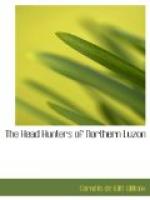[29] As a matter of fact, they were “the terror of the Spaniards”; they “annihilated an entire garrison at Payoan,” “exacted a heavy annual toll of heads from the people of Ragabag, and ... made the main trail from Nueva Vizcaya to Isabela so dangerous that three strong garrisons were constantly maintained on it, and ... people were not allowed to travel over it: except under military escort, and even so were often attacked and killed.” (Worcester, The National Geographic Magazine, March, 1911.) Gallman’s mere name now suffices to do what three strong Spanish garrisons failed to do.
[30] This danger still exists in the case of the savages of the Southern Islands of the Archipelago, but Mr. Worcester, if undisturbed, will bring these in too, all in time. In the fall of this very year, 1910, his party was attacked in Palawan.
[31] Many years ago some Moros were brought to Mayoyao to work tobacco. The Ifugaos deeply resenting this invasion, at the first opportunity attacked and killed them all. Only one woman escaped, covered with wounds, to Echaguee, where she was in 1910, still alive. The fight was most desperate, three Ifugaos biting the dust for every Moro killed.
[32] See a native account of the part played by the Igorots in this battle, in Seidenadel’s “The First Grammar of the Language Spoken by the Bontoc Igorot”; Chicago, Open Court Publishing Company, 1909.
[33] Sometimes also called the Caicayan.
[34] Samoki is celebrated for its pottery, sold all through this region, and of such quality that the Igorots use vessels made here to reduce copper ore. The potter’s wheel is unknown. In regard to the skill of the highlanders in metallurgy, see Jagor, “Travels,” p. 181.
[35] So do their cousins of Formosa. Pickering, “Pioneering in Formosa,” p. 150; London, Hurst & Blackett, 1898.
[36] For a full account of the way in which the Igorots have taken to our sports, see Mr. Worcester’s article in the March, 1911, number of the National Geographic Magazine.
[37] A similiar institution exists among the aborigines of Formosa. “... the unmarried men and boys slept in a shed raised from the ground. This building was regarded as a kind of temple, in which the vanquished heads were hung.” (Pickering, “Pioneering in Formosa,” p. 148.)
[38] For a more or less complete account of the Bontok Igorot, see Jenks’s “The Bontoc Igorot”; Manila, Bureau of Public Printing, 1905. For the language, consult “The First Grammar of the Language Spoken by the Bontoc Igorot,” by Doctor Carl Wilhelm Seidenadel; Chicago, Open Court Publishing Company, 1909.
[39] Dampier mentions this drink in his “New Voyage Around the World.” He calls it bashee, and found it in the Batanes Islands, just north of Luzon: “And indeed, from the plenty of this Liquor, and their plentiful use of it, our Men call’d all these Islands, the Bashee Islands.” (Masefield’s edition, p. 425.)




